This interview with Christo was published in the March 2020 issue of Apollo. The Centre Pompidou in Paris, where the artist’s exhibition was scheduled to open on 18 March, is currently closed due to Covid-19. New dates for the exhibition and updated plans for the wrapping of the Arc de Triomphe (scheduled for 19 September–4 October) have yet to be announced.
‘Each project has its own story,’ Christo tells me as we sit in his sparsely furnished studio in New York. One wall is dominated by a large-scale drawing of a wrapped Arc de Triomphe. The rendering shows the monument at night, and it is luminous, wrapped in a radiantly reflective fabric befitting the City of Light. More than is the case for any of Christo’s projects, the trajectory of L’Arc de Triomphe, Wrapped, which will finally be realised in September this year, is especially long: it is something Christo has dreamed of doing from the beginning of his career. The wrapping of the monument was originally planned to coincide with the upcoming exhibition at the Centre Pompidou [scheduled to run from 18 March–15 June], which will focus on the period when he was discovering his artistic voice while living in Paris from 1958 to 1964. This exhibition pays tribute to the origins of Christo the artist – after he fled Bulgaria’s authoritarian Communist regime, and the stifling, repressive art school in Sofia, for a country that embraced liberal ideas and modern art. ‘Freedom,’ Christo says, is what his work is about. The way he says it, in a deep, guttural voice, the word sounds like a stone that has been dragged over sharp rocks. ‘Freedom – with no justification.’
Christo’s own story is riveting: full of risk, and romance. Armed with little besides a few family connections and his excellent drafting and painting skills, Christo arrived in Paris and found lodging in a chambre de bonne (‘maid’s room’) on the top floor of a building that was half a block from the Champs-Élysées. He did various odd jobs to make money, including painting portraits. One such portrait will be on view at the Pompidou – the commission came from a glamorous society matron, Précilda de Guillebon. Young Christo, with his impish smile, determined gaze framed by thick black glasses, and heavily accented French, must have made quite an impression. He fell in love with De Guillebon’s daughter, Jeanne-Claude. The two became inseparable partners in life and work until Jeanne-Claude’s death in 2009. (Christo and Jeanne-Claude became official co-creators of their artworks in 1994, after years of her being the ‘silent’ collaborator.)
Wrapped Cans (1959–60), Christo. Photo: courtesy Tate; © Christo

That first year in Paris was also when he met key allies, such as the collector Dieter Rosenkranz in 1958. Christo got in touch with one of his father’s university friends, a Mr Rosenkranz, who lived in Wuppertal, Germany. ‘One day,’ he recalls, ‘I heard a knock in my maid’s room in 1958, and there was Mr Rosenkranz. And right away I understand, he was not an old man, the age of my father, he was the son of Mr Rosenkranz.’ Rosenkranz bought one of his earliest pieces, a wrapped can of paint, and introduced him to artists Mary Bauermeister, Karlheinz Stockhausen, Nam June Paik, and John Cage. The synchronicity of his meeting the right people at the right time, coupled with his singular focus and drive, eventually led to his first gallery exhibition in Cologne in 1961.
The seed for Christo and Jeanne-Claude’s desire to wrap a building was planted while they were preparing his exhibition. Inside the gallery was a conventional art show, a display of the wrapped paint cans and furniture for which Christo was becoming known. But he longed to make a grander gesture and seized the opportunity to make a stack of oil drums, cardboard barrels, and paper rolls lying on one of the docks on the Rhine river. He and Jeanne-Claude draped these objects in a large tarp, and titled it Dockside Packages, Cologne Harbor. Then, in August, the Berlin Wall was erected. Fearful of Soviet invasion, Christo and Jeanne-Claude hurried back to France where they made two defining works – one was a photomontage-and-text piece, Project for a Wrapped Public Building (1961), which features a wrapped building surrounded by pedestrians, cyclists and cars, that served as a manifesto for their desire to wrap a ‘public’ structure, one that could be used as ‘a prison or a parliament’. The other was Wall of Oil Barrels – The Iron Curtain (1961–62), a wall of iron barrels that blocked passage through the narrow Rue Visconti in Paris. The temporary monument screwed up Paris traffic for the duration – something Parisians may face again, since President Macron has ordered that the streets surrounding L’Arc de Triomphe, Wrapped be closed off to all but pedestrians, thus allowing larger crowds to admire the work.
Installation view of Wall of Oil Barrels – The Iron Curtain in the Rue Visconti, Paris (1961–62), Christo and Jeanne-Claude. Photo: Jean-Dominique Lajoux; © Christo
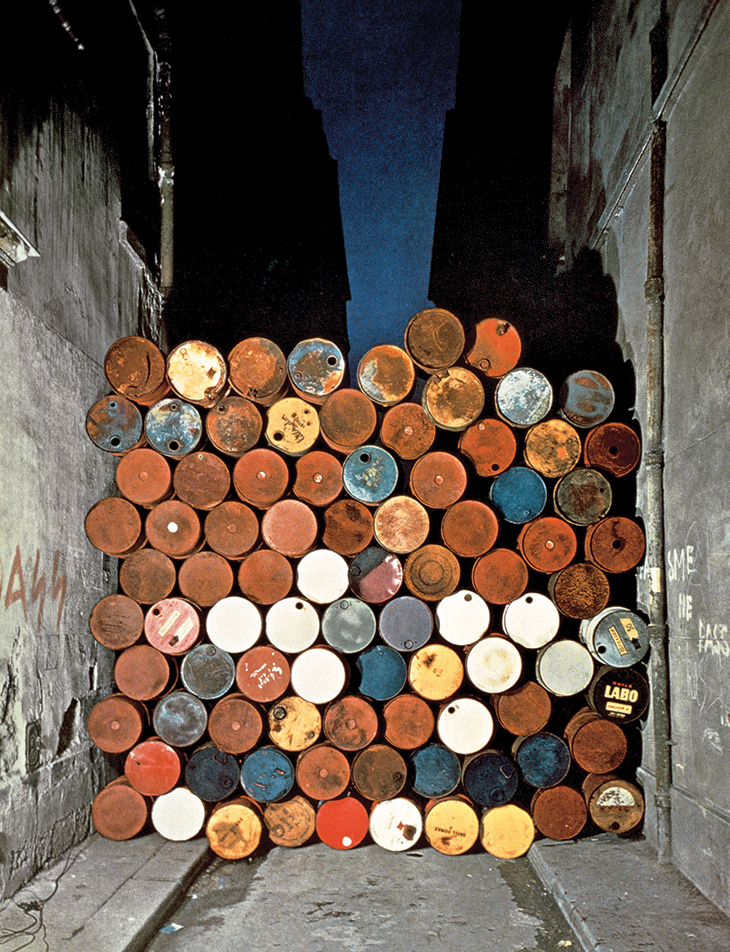
The best stories seem inevitable in retrospect, fated to follow a familiar path of struggle and success. But this kind of narrative downplays Christo and Jeanne-Claude’s willpower – and the parallel forces of history that shaped their career. Eager for a fresh start (and still haunted by the spectre of Soviet tanks rolling into Berlin), Christo and Jeanne-Claude made New York their home in 1964. They lived in the Chelsea Hotel for a few years before moving to a building in Soho that still serves as Christo’s studio and home. The projects take decades to complete, so how does he sustain his interest over the long periods when a project lies fallow, awaiting approval from a million public entities? ‘Each project is an enormous journey in life. Not boring at all.’ Over the course of 50 years they proposed some 70 projects; only a third have been realised.
Now 84 years old, Christo still has a wild mane of hair and a brain like a steel trap, easily recalling specific dates and names of people involved in getting his projects off the ground. ‘[Iron Curtain] was the root of Wrapped Reichstag,’ Christo says, referring to one of his and Jeanne-Claude’s most famous projects, which was realised in 1995. The artists came up with the idea in 1971 (after receiving a postcard from the American historian Michael Cullen suggesting they wrap the symbolic seat of Germany’s government in what was then West Berlin), officially proposing it in 1976. Over the following years, they would visit West Germany (and then a reunified Germany) more than 50 times, personally lobby some 300 members of parliament, and involve several heads of state. At the time the project was conceived, Berlin was still under French, British, American, and Soviet control. This was a crucial aspect of Christo and Jeanne-Claude’s initial idea. But by the time it went ahead, Germany was unified, the wall finally destroyed. Now the project represented something different – a country that was whole again, under entirely new circumstances. Christo remembers waiting nervously while the project was debated in the German parliament, and, when it seemed as though they would lose their bid, removing the renderings from his studio wall and putting up a new project in its place. Then he and Jeanne-Claude got word that the Bundestag had given them the go-ahead. In the end, an estimated half a million visitors came to see the work, which ushered in the return (in 1999) of the German parliament to Berlin (since the end of the Second World War the West German parliament had been located in Bonn).
Installation view of Wrapped Reichstag, Berlin (1971–95), Christo and Jeanne-Claude. Photo: Wolfgang Volz; © Christo

By the time Wrapped Reichstag finally happened, Christo and Jeanne-Claude were established artists who had completed several major projects. Their first wrapped building was the Kunsthalle Bern, in 1968, facilitated by the renowned curator Harald Szeemann, who was then director of the museum. They also mounted Valley Curtain, a startling orange banner stretched across Rifle Gap, a canyon in Colorado, in 1972, and Running Fence, a white nylon fabric screen that ran for 24.5 miles along roads in Northern California before dropping into the Pacific Ocean, in 1976. The artists also made Surrounded Islands, giving bright pink skirts to 11 islands in Miami’s Biscayne Bay in 1983, and wrapped the beloved 400-year-old Pont Neuf in Paris in 1985. Each of these projects required the artists to do rigorous structural testing, and they worked closely with engineers to ensure their designs were stable. Unsurprisingly, these relationships have endured for decades. Even the polypropylene fabric Christo uses was first developed by a German company for Surrounded Islands, and Christo has worked with that company ever since.
Installation view of Surrounded Islands, Biscayne Bay, Greater Miami, Florida (1980–83), Christo and Jeanne-Claude. Photo: Wolfgang Volz; © Christo
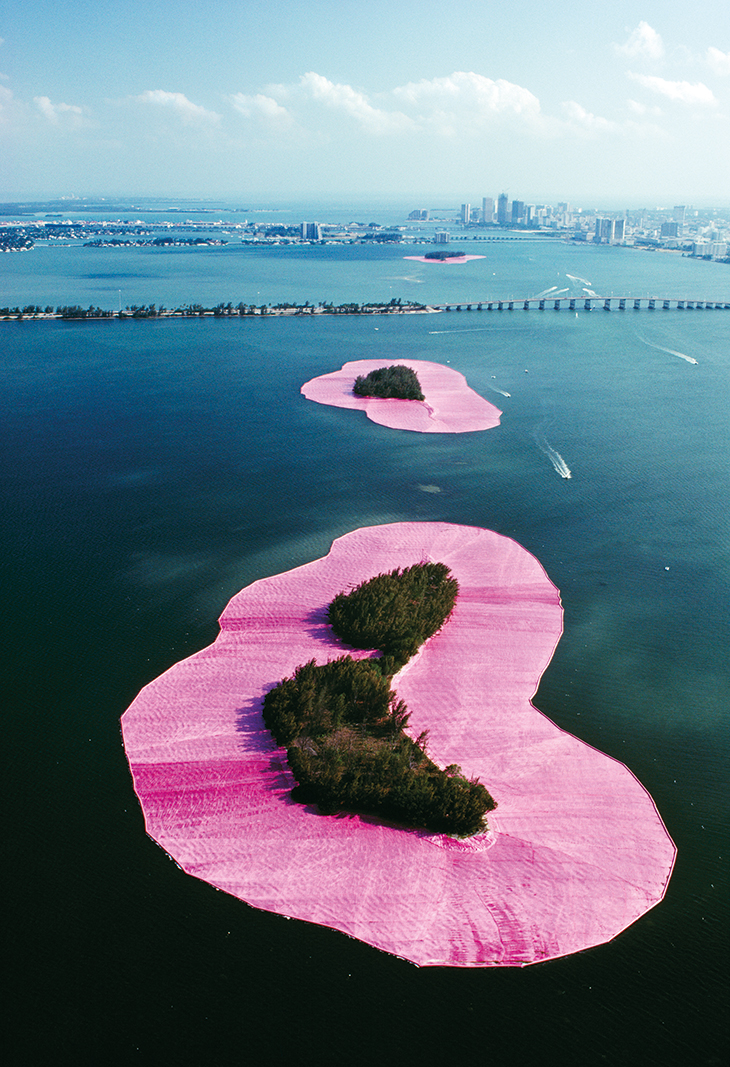
‘All of our projects have two phases,’ Christo says, by way of explaining the system he and Jeanne-Claude devised for bringing their schemes to fruition. ‘A hardware period, and a software period.’ The ‘hardware’ period entails all of the design and structural planning, while the ‘software’ period involves conditioning people to the installation of a project, as well as financing it. ‘I’m an educated Marxist,’ Christo says matter-of-factly. ‘We are absolutely using the capitalist system.’ Christo does not accept commissions and funds his own work. (‘Freedom cannot be invented,’ he says emphatically.) Each project is a subsidiary of Christo’s corporation, which is funded by the sale of the drawings and maquettes he makes of the project before it is realised. Although Christo treats his exquisite draughtsmanship lightly, claiming that the real art is in the ephemeral physical projects, he relies on his drawing and painting skills heavily to get his projects made. ‘When we start a new corporation,’ he explains, ‘that corporation needs to have cash flow. The most expensive project was Umbrellas in Japan and the United States. We did it in 1991, and it cost us near 30 million dollars. Today that would be closer to 70 or 80 million.’
So successful is Christo and Jeanne-Claude’s model that after they made The Gates in Central Park, New York, in 2005, Harvard Business School began teaching it as one of their case studies. The Gates is another project that gestated for years until a sympathetic administration, in the form of Mayor Michael Bloomberg, came along. Although New York was their home, Jeanne-Claude and Christo had never made a work there. Some may wonder why they didn’t wrap the Empire State Building or the Statue of Liberty, but Christo sounds like a true New Yorker when he says that what makes New York unique is the people who live there and make up its riveting street life. Because celebrating the teeming masses of pedestrians on city streets was too logistically difficult, he and Jeanne-Claude seized on Central Park as a platform of activity.
The Gates (Project for Central Park, New York City) (2001), Christo. © Christo
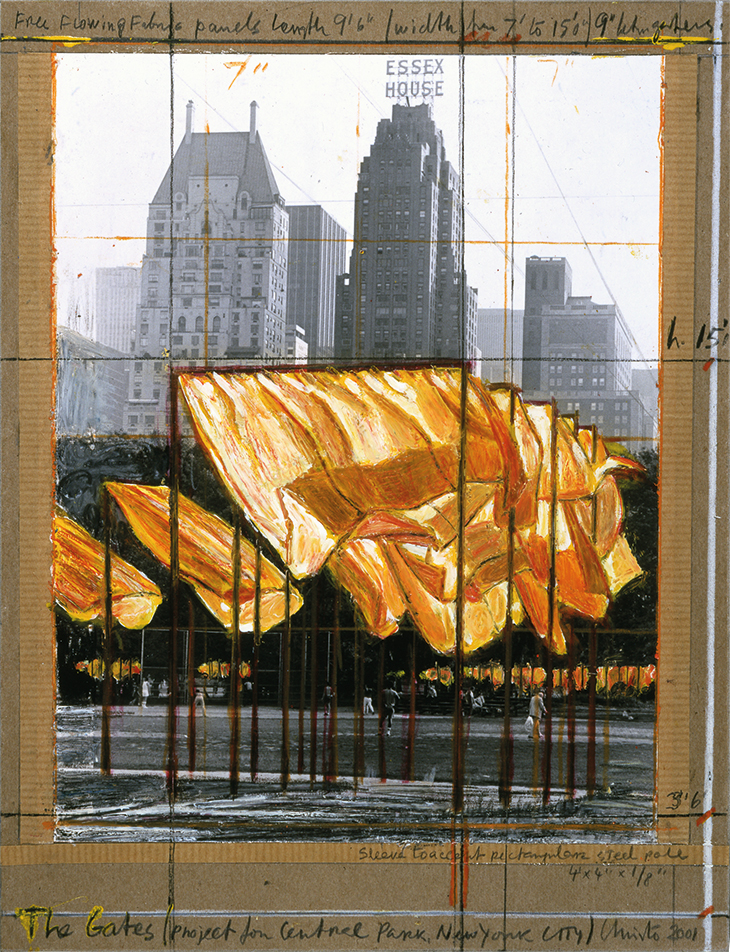
The Gates was received with mixed reviews. The critic and art historian Hal Foster, writing in the London Review of Books, dismissed the work as ‘spectacle’, calling it a ‘telling instance of high kitsch in the Bloomberg-Bush era’. By that point, the artists’ formula was becoming familiar – picking a site, exhibiting drawings and maquettes of the proposed design to, as Christo puts it, ‘sensitise’ locals to the eventual realisation of the project, and, finally, unveiling the project to great fanfare. Most people experience Christo’s work via photographic documentation, which is usually stunning: The Floating Piers, a bridge of gold-bedecked pontoons on a lake in Italy that was up in 2016 for 16 days, looked dazzling in the god’s-eye photographs. It was the artist’s first outdoor installation since The Gates, and his first in the Instagram era.
It is easy to make light of such grand works in an art world increasingly driven by opportunities for selfies – and perhaps the criticism is warranted, although Christo is the first to acknowledge that the work is ‘irrational, and useless’. But it is also easy to forget that the apparent pointlessness of the work is what made it special in the first place – that it is about the freedom to make whatever one likes, and to work collectively, which is enabled, and hopefully encouraged, by living in a democracy. The Maysles brothers made a series of films about Christo’s work, one of which documented the controversial installation of Running Fence in California. The film shows rancher families defending Christo’s work, while environmentalists and politicians decry it – and ultimately, the decision is put to a vote. At one point in the film Christo stands up in a crowded room and points out that this moment is part of the art work – the debate, and the participation of the public, is as much the art as are the billowing white panels following the line of the hills.
Installation view of Running Fence, Sonoma and Marin Counties (1972–76), Christo and Jeanne-Claude. Photo: Wolfgang Volz; © Christo
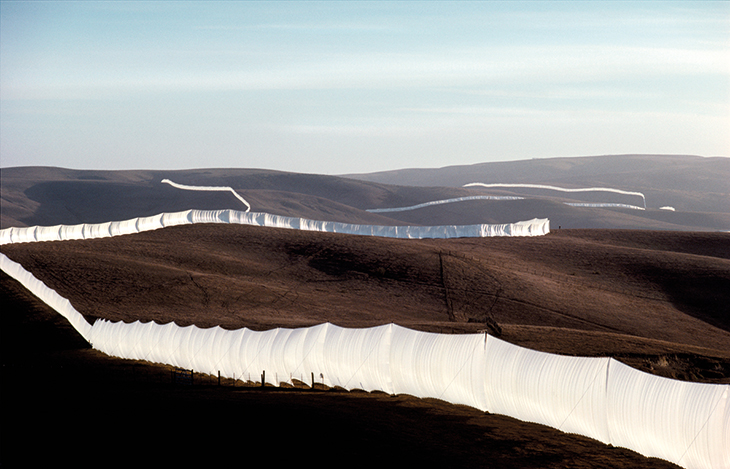
Such passion won many hearts – and one could argue that the artists played to so-called American values, such as individualism and a ‘can-do’ spirit. Running Fence marked a tipping point. It was during its making that Christo and Jeanne-Claude befriended Peanuts creator Charles Schulz, who lived in the area and argued in favour of the work. Schulz was such a fan that he even dedicated one of his comic strips to Christo and Jeanne-Claude, with the final panel showing Snoopy lying down on top of a wrapped doghouse. Christo later returned the compliment by giving Schulz an actual wrapped doghouse. (This comic is framed and on view in Christo’s bathroom, next to a handful of other cartoons about his and Jeanne-Claude’s work.) Joan Mondale, an arts advocate who was married to Walter Mondale, vice president during the Carter administration, widely screened the Maysles brothers’ film as an example of the success of democratic principles.
Perhaps the upcoming installation in Paris will restore some of the raw glory of Christo and Jeanne-Claude’s early days. The Pompidou exhibition and L’Arc de Triomphe, Wrapped will serve double duty – not only celebrating the artists’ past, but also signalling a triumphant future. To hear Christo tell the story, wrapping the landmark in the end came about far more easily than many of the artists’ previous endeavours. After a busy day of planning the exhibition of early works, Christo and Bernard Blistène, who is the director of the Pompidou, were leaving the museum and, while walking on the esplanade, Blistène told Christo that usually artists make a public artwork outside of the museum in conjunction with their exhibition. ‘And I say to Blistène,’ Christo recalls, ‘the only thing I want to do is the wrapping of the Arc de Triomphe. The irony is that, when I tell Blistène that I would like to do that, he takes me seriously. In less than a year, President Macron approves it. The things that happen in life unexpectedly. Since 1962 I did several studies of Arc but never thought I would get permission.’
L’Arc de Triomphe (Project for Paris) Place de l’Étoile – Charles de Gaulle (2019), Christo. Photo: André Grossmann; © Christo
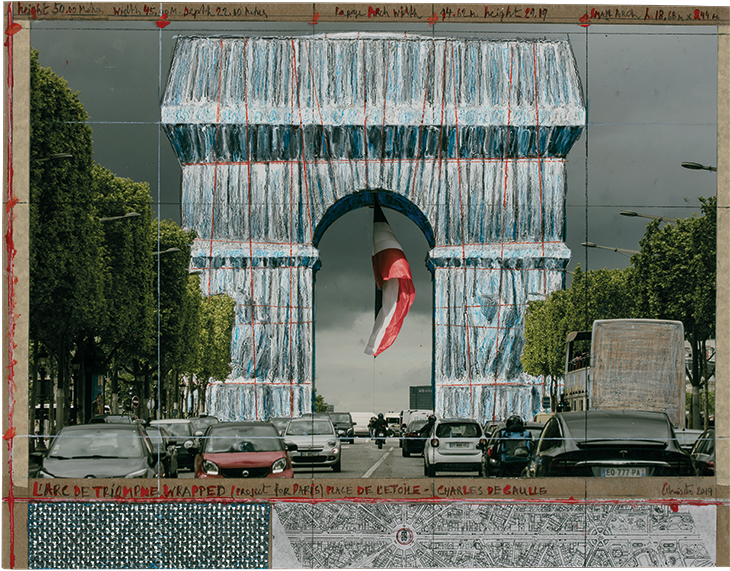
It is said that one reason Macron backed the project was to restore the monument in the eyes of the public, after it was defaced during the yellow vest protests in 2018. Christo is quick to note, however, that this does not mean that wrapping the Arc is in any way political. Yet it is hard to deny the powerful symbolism of an immense bandage around a national memorial to soldiers wounded while defending their country.
Christo is more interested in the way that the project has come full circle. One of the head engineers who will work on the project was part of the crew that wrapped the Pont Neuf in 1985. And even more importantly, he will be back in the city where he met Jeanne-Claude. ‘Perhaps she is behind this,’ he says with a winning smile. ‘Because, you know, as they say, “We will always have Paris.”’
From the March 2020 issue of Apollo. Preview and subscribe here.



